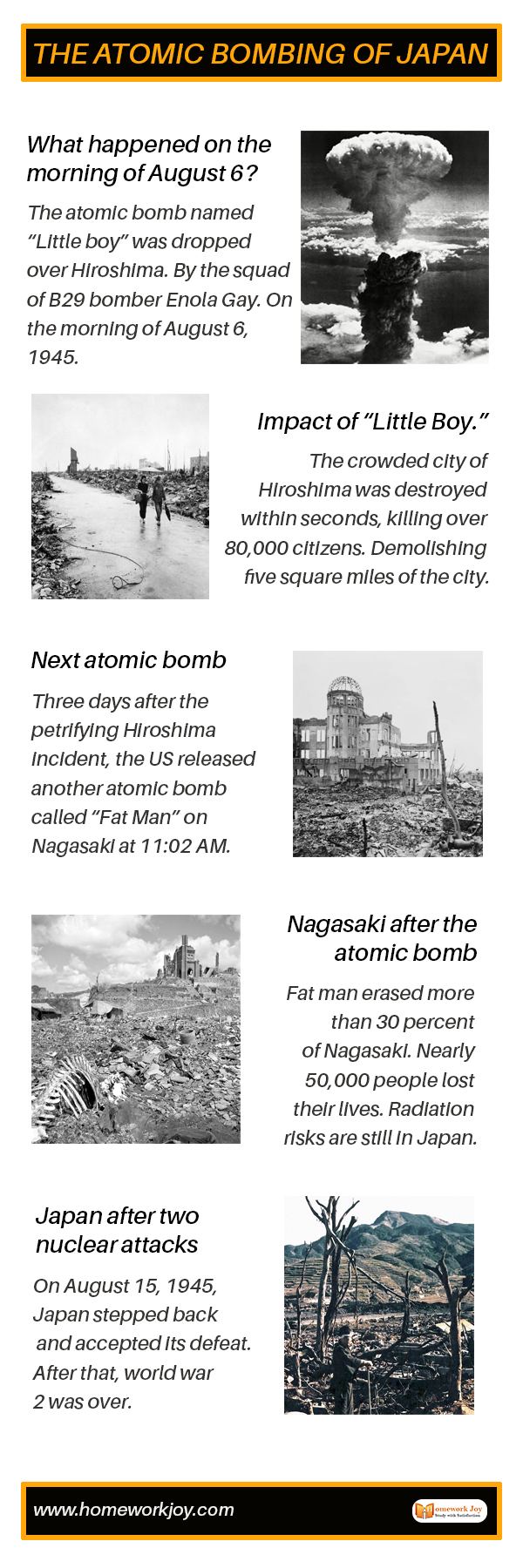The atomic bombing of Japan is a time of ending world war II, and the Allies arrange intrusion of the Japanese mainland. This bombing destroyed 67 cities of Japan.
The U.S. deployed the first bomb in Hiroshima city of Japan at least 80,000 people killed, and also the U.S. deployed the second bomb in Nagasaki city of Japan at least 40,000 people killed.
Also, radiation exposure killed many people.
What Happened on the Morning of August 6th and 9th
The U.S. exploded two nuclear weapons on the city of Japan in Hiroshima and Nagasaki on the 6th and 9th of August. The atomic bombs code-named “Little boy” and “Fat Man” were dropped over Hiroshima and Nagasaki.
The squad made an attack on B29 bomber Enola Gay on Hiroshima on August 6, 1945. After, three days later, again the team of B29 drop bombs on Nagasaki on the morning of August 9, 1945.
Impact of “Little Boy.”
In warfare, this bomb was used for the first time. The crowded city of Hiroshima was destroyed within seconds, killing over 80,000 citizens. It was demolishing five square miles of the town.
It caused extensive destruction and deaths all over the city. In history, it is the second human-made nuclear bomb activity.
Next Atomic Bomb
Three days after the petrifying Hiroshima incident, the U.S. released another atomic bomb called “Fat Man” on Nagasaki at 11:02 AM. It is such a powerful nuclear bomb compared to the Hiroshima attack; it is forty percent bigger.
But, because of the hills and industrial area of Nagasaki, not much loss happened there. According to reports, people and animals died within 1 kilometer. And all houses that are one and a half miles away were eradicated.
Hiroshima After the Atomic Bomb
Little boy erased more than 30 percent of Hiroshima. Nearly 140,000 people lost their lives. Because of this, ground temperature increases and reaches 4000-degree Celsius, and dangerous rain flows down.
During this incident, pregnant women faced many more problems because some faced miscarriage, confronted deaths among infants, and increased cancer risk.
Radiation risks are still in Japan because of the atomic bombing of Japan.
The Atomic Bombing of Japan
On August 15, 1945, Japan stepped back and accepted its defeat. After that, world war 2 was over.
According to the Quebec Agreement, the United Kingdom acquired for the bombing because on July 25; an order was issued for bombing against Hiroshima and Nagasaki.
The targets were selected after seeing the vast urban area and significant military facilities.
Japan’s Emperor Hirohito declared his country’s complete surrender in World War II in a radio location on August 15, referring to the overwhelming force of “another and most savage bomb.”
